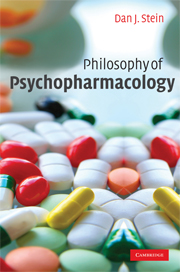Book contents
- Frontmatter
- Contents
- Preface
- 1 Psychopharmacology – a remarkable development
- 2 Philosophical questions raised by psychopharmacology
- 3 How to think about science, language, and medicine: classical, critical, and integrated perspectives
- 4 Conceptual questions about psychotropics
- 5 Explanatory questions about psychotropics
- 6 Moral questions about psychotropics
- 7 Conclusion
- References
- Index
3 - How to think about science, language, and medicine: classical, critical, and integrated perspectives
Published online by Cambridge University Press: 13 August 2009
- Frontmatter
- Contents
- Preface
- 1 Psychopharmacology – a remarkable development
- 2 Philosophical questions raised by psychopharmacology
- 3 How to think about science, language, and medicine: classical, critical, and integrated perspectives
- 4 Conceptual questions about psychotropics
- 5 Explanatory questions about psychotropics
- 6 Moral questions about psychotropics
- 7 Conclusion
- References
- Index
Summary
To address specific conceptual questions about psychopharmacology, we first need to consider a number of larger questions about science, about language, about medicine, and even about philosophy. In many ways, this volume is about all of these issues. However, we need to begin with a single starting point, and so we will begin with what is perhaps the most important question in philosophy of medicine: “What is a medical disorder?”, and perhaps the most important question in philosophy of psychiatry: “What is a psychiatric disorder?” (Engelhardt, 2000; Engelhardt & Spicker, 1977; Stempsey, 2004).
These turn out to be useful questions-with-which-to-think (Papert, 1980). Beginning with these two questions provides an opportunity to demonstrate the approach taken throughout this volume. First, the two questions are central to medicine and to psychiatry, and so provide a segue into many other issues. Second, there have been well-delineated formal definitions of disorder (the classical approach) as well as a range of arguments that no scientific response is possible (the critical approach); providing a foundation on which a contrasting position can be built here.
The position here draws on cognitive-affective science and emphasizes that the brain-mind is embodied. Over the course of this chapter we will gradually try to reach a conclusion that sensorimotor-affective neuronal circuitry allows humans to interact with their physical and social world, and this in turn leads to the development of basic-level and abstract cognitive-affective maps (or metaphors) for understanding the world.
- Type
- Chapter
- Information
- Philosophy of Psychopharmacology , pp. 17 - 42Publisher: Cambridge University PressPrint publication year: 2008



